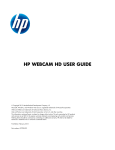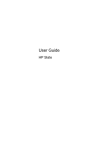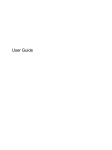Download Windows 7 - NetShop AS
Transcript
Getting Started HP Notebook © Copyright 2012 Hewlett-Packard Development Company, L.P. Bluetooth is a trademark owned by its proprietor and used by Hewlett-Packard Company under license. Microsoft and Windows are U.S. registered trademarks of Microsoft Corporation. SD Logo is a trademark of its proprietor. The information contained herein is subject to change without notice. The only warranties for HP products and services are set forth in the express warranty statements accompanying such products and services. Nothing herein should be construed as constituting an additional warranty. HP shall not be liable for technical or editorial errors or omissions contained herein. First Edition: January 2013 Document Part Number: 709343-001 Product notice Software terms This guide describes features that are common to most models. Some features may not be available on your computer. By installing, copying, downloading, or otherwise using any software product preinstalled on this computer, you agree to be bound by the terms of the HP End User License Agreement (EULA). If you do not accept these license terms, your sole remedy is to return the entire unused product (hardware and software) within 14 days for a refund subject to the refund policy of your place of purchase. To obtain the latest information in this guide, contact support. For U.S. support, go to http://www.hp.com/go/contactHP. For worldwide support, go to http://welcome.hp.com/country/us/en/ wwcontact_us.html. For any further information or for requesting a full refund of the computer, please contact your local point of sale (the seller). Safety warning notice WARNING! To reduce the possibility of heat-related injuries or of overheating the computer, do not place the computer directly on your lap or obstruct the computer air vents. Use the computer only on a hard, flat surface. Do not allow another hard surface, such as an adjoining optional printer, or a soft surface, such as pillows or rugs or clothing, to block airflow. Also, do not allow the AC adapter to come into contact with the skin or a soft surface, such as pillows or rugs or clothing, during operation. The computer and the AC adapter comply with the user-accessible surface temperature limits defined by the International Standard for Safety of Information Technology Equipment (IEC 60950). iii iv Safety warning notice Table of contents 1 Welcome .......................................................................................................................................................... 1 Finding information ............................................................................................................................... 2 2 Getting to know your computer ..................................................................................................................... 4 Top ....................................................................................................................................................... 4 TouchPad ............................................................................................................................ 4 Lights ................................................................................................................................... 5 Keys ..................................................................................................................................... 6 Right ..................................................................................................................................................... 7 Left ....................................................................................................................................................... 8 Rear ...................................................................................................................................................... 8 Display ................................................................................................................................................ 10 Bottom ................................................................................................................................................ 12 3 Networking .................................................................................................................................................... 13 Using an Internet service provider (ISP) ............................................................................................ 13 Connecting to a wireless network ....................................................................................................... 14 Connecting to an existing WLAN ....................................................................................... 14 Setting up a new WLAN network ....................................................................................... 14 Configuring a wireless router ............................................................................ 15 Protecting your WLAN ....................................................................................... 15 Using HP Mobile Broadband (select models only) ............................................................ 15 Inserting and removing a SIM ........................................................................... 16 Using GPS (select models only) ........................................................................................ 17 Using Bluetooth wireless devices (select models only) ..................................................... 17 Connecting to a wired network ........................................................................................................... 18 Connecting to a local area network (LAN) ......................................................................... 18 4 Multimedia ..................................................................................................................................................... 19 Using the media activity controls ........................................................................................................ 19 Audio .................................................................................................................................................. 19 v Adjusting the volume ......................................................................................................... 20 Checking audio functions on the computer ........................................................................ 20 Webcam (select models only) ............................................................................................................ 21 Video .................................................................................................................................................. 21 DisplayPort ........................................................................................................................ 21 5 External cards and devices .......................................................................................................................... 23 Using Media Card Reader cards (select models only) ....................................................................... 23 Inserting a digital card ........................................................................................................ 23 Removing a digital card ..................................................................................................... 24 Using a USB device ........................................................................................................................... 24 Connecting a USB device .................................................................................................. 25 Removing a USB device .................................................................................................... 25 Using optional external devices .......................................................................................................... 25 Using optional external drives ............................................................................................ 26 Using the docking connector (select models only) ............................................................ 26 6 Power management ...................................................................................................................................... 27 Shutting down the computer ............................................................................................................... 27 Setting power options ......................................................................................................................... 28 Using power-saving states ................................................................................................. 28 Intel Rapid Start Technology (select models only) ............................................ 28 Initiating and exiting Sleep ................................................................................ 28 Initiating and exiting Hibernation ....................................................................... 29 Using the power meter ....................................................................................................... 29 Using power plans ............................................................................................................. 29 Viewing the current power plan ......................................................................... 29 Selecting a different power plan ........................................................................ 29 Customizing power plans .................................................................................. 30 Setting password protection on wakeup ............................................................................ 30 Using battery power ........................................................................................................................... 30 Finding additional battery information ................................................................................ 31 Using Battery Check .......................................................................................................... 31 Displaying the remaining battery charge ........................................................................... 31 Maximizing battery discharge time .................................................................................... 31 Managing low battery levels .............................................................................................. 31 Identifying low battery levels ............................................................................. 32 Resolving a low battery level ............................................................................. 32 Resolving a low battery level when external power is available ....... 32 Resolving a low battery level when no power source is available .... 32 vi Resolving a low battery level when the computer cannot exit Hibernation ....................................................................................... 32 Conserving battery power .................................................................................................. 32 Storing a user-replaceable battery (select models only) .................................................... 33 Disposing of a user-replaceable battery (select models only) ........................................... 33 Replacing a user-replaceable battery (select models only) ............................................... 33 Using external AC power .................................................................................................................... 33 Testing an AC adapter ....................................................................................................... 34 7 Keyboard and pointing devices ................................................................................................................... 35 Using the keyboard ............................................................................................................................ 35 Identifying the Hot keys ..................................................................................................... 35 Using keypads ................................................................................................................... 37 Using the embedded numeric keypad ............................................................... 37 Turning the embedded numeric keypad on and off .......................... 37 Switching key functions on the embedded numeric keypad ............. 38 Using an optional external numeric keypad ...................................................... 38 Using pointing devices ....................................................................................................................... 38 Setting pointing device preferences ................................................................................... 38 Using the TouchPad .......................................................................................................... 38 Turning the TouchPad off and on ...................................................................... 39 Navigating ......................................................................................................... 39 Selecting ........................................................................................................... 40 Using TouchPad gestures ................................................................................. 40 Scrolling ............................................................................................ 41 Pinching/Zooming ............................................................................. 41 Rotating (select models only) ........................................................... 42 8 Maintenance .................................................................................................................................................. 43 Inserting or removing the battery ........................................................................................................ 43 Removing or replacing the service door ............................................................................................. 45 Removing the service door ................................................................................................ 45 Replacing the service door ................................................................................................ 46 Replacing or upgrading the hard drive ............................................................................................... 47 Removing the hard drive .................................................................................................... 47 Installing a hard drive ......................................................................................................... 48 Adding or replacing memory modules ............................................................................... 49 Updating programs and drivers .......................................................................................................... 51 Cleaning your computer ..................................................................................................................... 52 Cleaning products .............................................................................................................. 52 Cleaning procedures .......................................................................................................... 52 vii Cleaning the display .......................................................................................... 52 Cleaning the sides and cover ............................................................................ 52 Cleaning the TouchPad and keyboard .............................................................. 53 9 Backup and recovery .................................................................................................................................... 54 Creating recovery media with HP Recovery Disc Creator .................................................................. 55 Creating recovery media .................................................................................................... 55 Backing up your information ............................................................................................................... 55 Performing a system recovery ............................................................................................................ 56 Using the Windows recovery tools ..................................................................................... 56 Using f11 recovery tools .................................................................................................... 57 Using a Windows 7 operating system DVD (purchased separately) ................................. 58 10 Support ........................................................................................................................................................ 59 Contacting support ............................................................................................................................. 59 Labels ................................................................................................................................................. 60 11 Specifications .............................................................................................................................................. 61 Input power ......................................................................................................................................... 61 Operating environment ....................................................................................................................... 62 Index ................................................................................................................................................................... 63 viii 1 Welcome After you set up and register the computer, it is important to take the following steps: ● Connect to the Internet—Set up your wired or wireless network so that you can connect to the Internet. For more information, see Networking on page 13. ● Update your antivirus software—Protect your computer from damage caused by viruses. The software is preinstalled on the computer and includes a limited subscription for free updates. For more information, see the HP Notebook Reference Guide. For instructions on accessing this guide, see Finding information on page 2. ● Get to know your computer—Learn about your computer features. See Getting to know your computer on page 4 and Keyboard and pointing devices on page 35 for additional information. ● Find installed software—Access a list of the software preinstalled on the computer. Select Start > All Programs. For details about using the software included with the computer, see the software manufacturer's instructions, which may be provided with the software or on the manufacturer's website. 1 Finding information The computer comes with several resources to help you perform various tasks. Resources For information about Setup Instructions poster ● How to set up the computer ● Help to identify computer components HP Notebook Reference Guide ● Power management features To access this guide on your computer: ● How to maximize battery life Select Start > Help and Support > User Guides. ● How to use the multimedia features of the computer ● How to protect the computer ● How to care for the computer ● How to update the software ● How to install certain components ● How to create a wired and/or wireless network Help and Support ● Operating system information To access Help and Support, select Start > Help and Support. ● Software, driver, and BIOS updates ● Troubleshooting tools ● How to access support Regulatory, Safety, and Environmental Notices ● Regulatory and safety information To access this guide: ● Battery disposal information Safety & Comfort Guide ● Proper workstation setup, posture, health, and work habits To access this guide: ● Electrical and mechanical safety information NOTE: For U.S. support, go to http://www.hp.com/ go/contactHP. For worldwide support, go to http://welcome.hp.com/country/us/en/ wwcontact_us.html. Select Start > Help and Support > User Guides. Select Start > Help and Support > User Guides. – or – Go to http://www.hp.com/ergo. Worldwide Telephone Numbers booklet HP support telephone numbers This booklet is provided with your computer. 2 HP website ● Support information For U.S. support, go to http://www.hp.com/go/ contactHP. For worldwide support, go to http://welcome.hp.com/country/us/en/ wwcontact_us.html. ● Ordering parts and finding additional help ● Accessories available for the device Chapter 1 Welcome Resources For information about Limited Warranty* Warranty information To access the warranty: Select Start > Help and Support > User Guides > View Warranty Information. – or – Go to http://www.hp.com/go/orderdocuments. *You can find the expressly provided HP Limited Warranty applicable to your product located with the user guides on your computer and/or on the CD/DVD provided in the box. In some countries/regions, HP may provide a printed HP Limited Warranty in the box. For some countries/regions where the warranty is not provided in printed format, you may request a printed copy from http://www.hp.com/go/orderdocuments or write to: ● North America: Hewlett-Packard, MS POD, 11311 Chinden Blvd., Boise, ID 83714, USA ● Europe, Middle East, Africa: Hewlett-Packard, POD, Via G. Di Vittorio, 9, 20063, Cernusco s/Naviglio (MI), Italy ● Asia Pacific: Hewlett-Packard, POD, P.O. Box 200, Alexandra Post Office, Singapore 9115077 When you request a printed copy of your warranty, please include your product number, warranty period (found on your service label), name, and postal address. IMPORTANT: Do NOT return your HP product to the addresses above. For U.S. support, go to http://www.hp.com/go/ contactHP. For worldwide support, go to http://welcome.hp.com/country/us/en/wwcontact_us.html. Finding information 3 2 Getting to know your computer Top TouchPad NOTE: Your computer may look slightly different from the illustration in this section. Component 4 Description (1) TouchPad on/off button Turns the TouchPad on and off. (2) TouchPad zone Moves the pointer and selects or activates items on the screen. (3) Left TouchPad button Functions like the left button on an external mouse. (4) Right TouchPad button Functions like the right button on an external mouse. Chapter 2 Getting to know your computer Lights NOTE: Your computer may look slightly different from the illustration in this section. Component Description (1) Caps lock light On: Caps lock is on. (2) Mute light ● Amber: Computer sound is off. ● Off: Computer sound is on. ● Amber: Microphone is muted. ● Off: Microphone is on. ● Amber: An integrated wireless device, such as a wireless local area network (WLAN) device and/or a Bluetooth® device, is on. ● Off: All wireless devices are off. (3) (4) Microphone mute light Wireless light (5) Num lock light On: Num lock is on. (6) TouchPad light ● Amber: The TouchPad is off. ● Off: The TouchPad is on. Top 5 Keys NOTE: Your computer may look slightly different from the illustration in this section. Component Description (1) esc key Displays system information when pressed in combination with the fn key. (2) fn key Executes frequently used system functions when pressed in combination with a function key, the num lk key, the esc key, or the b key. (3) Windows key Returns you to the Start screen from an open app or the Windows desktop. NOTE: Pressing the Windows key again will return you to the previous screen. (4) Function keys Execute frequently used system functions when pressed in combination with the fn key. (5) Embedded numeric keypad When the keypad is turned on, it can be used like an external numeric keypad. Each key on the keypad performs the function indicated by the icon in the upper-right corner of the key. (6) 6 Windows applications key Chapter 2 Getting to know your computer Displays options for a selected object. Right Component Description (1) Power button Turns power on and off. (2) Power light ● On: The computer is on. ● Blinking: The computer is in the Sleep state. ● Off: The computer is off. (3) Rotation lock button Locks screen orientation in either Landscape or Portrait mode. NOTE: When you move between notebook and tablet configuration, the computer screen will automatically change to vertical or horizontal. To lock the current screen orientation, slide the screen orientation button. (4) Volume button Lowers the volume. (5) Volume button Raises the volume. (6) Speaker Produces sound. (7) Digital Media Card Reader Supports a micro SD High Capacity (SDHC) memory card or an optional wireless micro subscriber identity module (SIM) (8) Audio-out (headphone) jack/Audio-in (microphone) jack Produces sound when connected to optional powered stereo speakers, headphones, earbuds, a headset, or television audio. Also connects an optional headset microphone. WARNING! To reduce the risk of personal injury, adjust the volume before putting on headphones, earbuds, or a headset. For additional safety information, see the Regulatory, Safety, and Environmental Notices. To access the user guides, select the HP Support Assistant app on the Start screen, select My computer, and then select User guides. NOTE: When a device is connected to the jack, the computer speakers are disabled. NOTE: Be sure that the device cable has a 4-conductor connector that supports both audio-out (headphone) and audio-in (microphone). (9) Docking port Connects an optional docking device. Right 7 Left NOTE: Your computer may look slightly different from the illustration in this section. Component (1) Description Vent Enables airflow to cool internal components. NOTE: The computer fan starts up automatically to cool internal components and prevent overheating. It is normal for the internal fan to cycle on and off during routine operation. (2) Speaker Produces sound. Rear NOTE: Your computer may look slightly different from the illustration in this section. Component Description (1) RJ-45 (network) jack Connects a network cable. (2) USB 3.0 ports (1) Connect optional USB 3.0 devices and provide enhanced USB power performance. NOTE: For details about different types of USB ports, see Using a USB device on page 24. (3) Security cable slot Attaches an optional security cable to the computer. NOTE: The security cable is designed to act as a deterrent, but it may not prevent the computer from being mishandled or stolen. (4) 8 DisplayPort Chapter 2 Getting to know your computer Connects an optional digital display device, such as a high-performance monitor or projector. (5) USB 3.0 charging port Connects an optional USB device. The USB 3.0 charging port can also charge select models of cell phones and MP3 players, even when the computer is off. NOTE: A USB charging port (also referred to as a powered USB port) allows you to charge connected USB devices. Standard USB ports will not charge all USB devices or will charge using a low current. Some USB devices require power and require you to use a powered port. NOTE: For details about different types of USB ports, see Using a USB device on page 24. (6) Power connector Connects an AC adapter. (7) AC adapter light ● White: The AC adapter is connected and the battery is charged. ● Amber: The AC adapter is connected and the battery is charging. ● Off: The computer is using DC power. Rear 9 Display Your computer can serve as both a standard notebook and can rotate into a tablet configuration, allowing you to use its touchscreen capabilities with a large number of apps. CAUTION: To prevent damage to the display hinges, never force the rotating action. 10 Chapter 2 Getting to know your computer CAUTION: To prevent damage to the display hinges, when in notebook configuration, do not rotate the display counterclockwise. To change your notebook to a tablet 1. Rotate the display clockwise 180 degrees until the display faces backwards. 2. Lower the display over the keyboard. To change the tablet back into a notebook, reverse these steps. Component Description (1) Ambient light sensor Brightens or dims the display in response to ambient light. (2) WLAN antennas (2)* Send and receive wireless signals to communicate with wireless local area networks (WLAN). (3) WWAN antennas (2)* Send and receive wireless signals to communicate with wireless wide area networks (WWAN). (4) Internal microphones (2) Record sound. (5) Webcam light On: The webcam is in use. (6) Webcam Records video and captures still photographs. For information on using the webcam, access Help and Support. From the Start screen, type h, and then select Help and Support. (7) Windows Home button Returns you to the Start screen. *The antennas are not visible on the outside of the computer. For optimal transmission, keep the areas immediately around the antennas free from obstructions. To see wireless regulatory notices, see the section of the Regulatory, Safety, and Environmental Notices that applies to your country or region. To access the user guides, select the HP Support Assistant app on the Start screen, select My computer, and then select User guides. Display 11 Bottom NOTE: Your computer may look slightly different from the illustration in this section. Component (1) Description Service cover Contains the hard drive, the wireless LAN module slot, the WWAN module slot (select models only), and the memory module slots. CAUTION: To prevent an unresponsive system, replace the wireless module only with a wireless module authorized for use in the computer by the governmental agency that regulates wireless devices in your country or region. If you replace the module and then receive a warning message, remove the module to restore computer functionality, and then contact support through Help and Support. (2) Vents (2) Enable airflow to cool internal components. NOTE: The computer fan starts up automatically to cool internal components and prevent overheating. It is normal for the internal fan to cycle on and off during routine operation. 12 (3) Near Field Communication (NFC) antenna With HP TouchZone, you can wirelessly connect, communicate and transfer data/info to and from your Near Field Communication (NFC)-compatible devices. (4) Battery bay Holds the battery. (5) Battery bay cover release latch Releases the battery cover over the battery bay. Chapter 2 Getting to know your computer 3 Networking NOTE: Internet hardware and software features vary depending on computer model and your location. Your computer may support one or both of the following types of Internet access: ● Wireless—For mobile Internet access, you can use a wireless connection. For more information, see Connecting to an existing WLAN on page 14 or Setting up a new WLAN network on page 14. ● Wired—You can access the Internet by connecting to a wired network. For information on connecting to a wired network, see the HP Notebook Reference Guide. Using an Internet service provider (ISP) Before you can connect to the Internet, you must establish an ISP account. Contact a local ISP to purchase Internet service and a modem. The ISP will help set up the modem, install a network cable to connect your wireless computer to the modem, and test the Internet service. NOTE: Your ISP will give you a user ID and password to access the Internet. Record this information and store it in a safe place. The following features will help you set up a new Internet account or configure the computer to use an existing account: ● Internet Services & Offers (available in some locations)—This utility assists with signing up for a new Internet account and configuring the computer to use an existing account. To access this utility, select Start > All Programs > Communication and Chat. ● ISP-provided icons (available in some locations)—These icons may be displayed either individually on the Windows desktop or grouped in a desktop folder named Online Services. To set up a new Internet account or configure the computer to use an existing account, double-click an icon, and then follow the on-screen instructions. ● Windows Connect to the Internet Wizard—You can use the Windows Connect to the Internet Wizard to connect to the Internet in any of these situations: ◦ You already have an account with an ISP. ◦ You do not have an Internet account and want to select an ISP from the list provided within the wizard. (The list of ISP providers is not available in all regions.) ◦ You have selected an unlisted ISP, and the ISP has provided you with information such as a specific IP address and POP3 and SMTP settings. Using an Internet service provider (ISP) 13 To access the Windows Connect to the Internet Wizard and instructions for using it, select Start > Control Panel > Network and Internet > Network and Sharing Center. NOTE: If you are prompted within the wizard to choose between enabling or disabling Windows Firewall, choose to enable the firewall. Connecting to a wireless network Wireless technology transfers data across radio waves instead of wires. Your computer may be equipped with one or more of the following wireless devices: ● Wireless local area network (WLAN) device ● HP Mobile Broadband Module, a wireless wide area network (WWAN) device ● Bluetooth device For more information on wireless technology and connecting to a wireless network, see the HP Notebook Reference Guide and information and website links provided in Help and Support. Connecting to an existing WLAN 1. Turn on the computer. 2. Be sure that the WLAN device is on. 3. Click the network icon in the notification area, at the far right of the taskbar. 4. Select a WLAN to connect to. NOTE: If no WLANs are listed, you may be out of range of a wireless router or access point. NOTE: If you do not see the WLAN you want to connect to, click Open Network and Sharing Center, and then click Set up a new connection or network. A list of options is displayed. You can choose to manually search for and connect to a network or to create a new network connection. 5. Click Connect. 6. If the network is a security-enabled WLAN, you are prompted to enter a network security code. Type the code, and then click OK to complete the connection. Setting up a new WLAN network Required equipment: ● A broadband modem (either DSL or cable) (purchased separately) (1) and high-speed Internet service purchased from an Internet service provider (ISP) ● A wireless router (purchased separately) (2) ● Your new wireless computer (3) NOTE: Some modems have a built-in wireless router. Check with your ISP to determine what type of modem you have. 14 Chapter 3 Networking The illustration shows an example of a completed WLAN network installation that is connected to the Internet. As your network grows, additional wireless and wired computers can be connected to the network to access the Internet. Configuring a wireless router For help in setting up a WLAN, see the information provided by your router manufacturer or your ISP. The Windows operating system also provides tools to help you set up a new wireless network. To use the Windows tools to set up your network: ● Select Start > Control Panel > Network and Internet > Network and Sharing Center > Set up a new connection or network > Set up a network. Then follow the on-screen instructions. NOTE: It is recommended that you initially connect your new wireless computer to the router by using the network cable provided with the router. When the computer successfully connects to the Internet, you can disconnect the cable, and then access the Internet through your wireless network. Protecting your WLAN When you set up a WLAN or access an existing WLAN, always enable security features to protect your network from unauthorized access. For information on protecting your WLAN, see the HP Notebook Reference Guide. Using HP Mobile Broadband (select models only) HP Mobile Broadband enables your computer to use WWANs to access the Internet from more places and over larger areas than it can by using WLANs. Using HP Mobile Broadband requires a network service provider (called a mobile network operator), which in most cases is a cellular phone network operator. Coverage for HP Mobile Broadband is similar to cellular phone voice coverage. When used with mobile network operator service, HP Mobile Broadband gives you the freedom to stay connected to the Internet, send email, or connect to your corporate network whether you are on the road or outside the range of Wi-Fi hotspots. HP supports the following technologies: ● HSPA (High Speed Packet Access), which provides access to networks based on the Global System for Mobile Communications (GSM) telecommunications standard. ● EV-DO (Evolution Data Optimized), which provides access to networks based on the code division multiple access (CDMA) telecommunications standard. You may need the HP Mobile Broadband Module serial number to activate mobile broadband service. Some mobile network operators require the use of a SIM. A SIM contains basic information about you, such as a personal identification number (PIN), as well as network information. Some computers include a SIM that is preinstalled in the battery bay. If the SIM is not preinstalled, it may be provided Connecting to a wireless network 15 in the HP Mobile Broadband information provided with your computer or the mobile network operator may provide it separately from the computer. For information about inserting and removing the SIM, see the Inserting and removing a SIM on page 16 section in this chapter. For information about HP Mobile Broadband and how to activate service with a preferred mobile network operator, see the HP Mobile Broadband information included with your computer. For additional information, see the HP website at http://www.hp.com/go/mobilebroadband (select regions/ countries only). Inserting and removing a SIM CAUTION: To prevent damage to the connectors, use minimal force when inserting a SIM. To insert a SIM, follow these steps: 1. Shut down the computer. 2. Close the display. 3. Disconnect all external devices connected to the computer. 4. Unplug the power cord from the AC outlet. 5. Turn the computer upside down on a flat surface, with the battery bay toward you. 6. Remove the battery. 7. Insert the SIM into the SIM slot, and gently push the SIM into the slot until it is firmly seated. NOTE: This computer uses micro SIM cards, which are smaller than standard SIM cards. A standard SIM card will not fit into this slot. NOTE: See the image on the battery bay to determine which way the SIM card should be inserted into your computer. 8. Replace the battery. NOTE: HP Mobile Broadband will be disabled if the battery is not replaced. 16 Chapter 3 Networking 9. Reconnect external power. 10. Reconnect external devices. 11. Turn on the computer. To remove a SIM, press in on the SIM, and then remove it from the slot. Using GPS (select models only) Your computer may be equipped with a Global Positioning System (GPS) device. GPS satellites deliver location, speed, and direction information to GPS-equipped systems. For more information, see the HP GPS and Location software Help. Using Bluetooth wireless devices (select models only) A Bluetooth device provides short-range wireless communications that replace the physical cable connections that traditionally link electronic devices such as the following: ● Computers (desktop, notebook, PDA) ● Phones (cellular, cordless, smart phone) ● Imaging devices (printer, camera) ● Audio devices (headset, speakers) ● Mouse Bluetooth devices provide peer-to-peer capability that allows you to set up a personal area network (PAN) of Bluetooth devices. For information about configuring and using Bluetooth devices, see the Bluetooth software Help. Connecting to a wireless network 17 Connecting to a wired network There are 2 kinds of wired connections: local area network (LAN) and modem connection. A LAN connection uses a network cable and is much faster than a modem, which uses a telephone cable. Both cables are sold separately. WARNING! To reduce the risk of electric shock, fire, or damage to the equipment, do not plug a modem cable or telephone cable into an RJ-45 (network) jack. Connecting to a local area network (LAN) Use a LAN connection if you want to connect the computer directly to a router in your home (instead of working wirelessly), or if you want to connect to an existing network at your office. Connecting to a LAN requires an 8-pin, RJ-45 network cable. To connect the network cable, follow these steps: 1. Plug the network cable into the network jack (1) on the computer. 2. Plug the other end of the network cable into a network wall jack (2) or router. NOTE: If the network cable contains noise suppression circuitry (3), which prevents interference from TV and radio reception, orient the circuitry end of the cable toward the computer. 18 Chapter 3 Networking 4 Multimedia Your computer may include the following multimedia components: ● Integrated speaker(s) ● Integrated microphone(s) ● Integrated webcam ● Preinstalled multimedia software ● Multimedia buttons or keys Using the media activity controls Depending on your computer model, you may have the following media activity controls that allow you to play, pause, fast forward, or rewind a media file: ● Media buttons ● Media hotkeys (specific keys pressed in combination with the fn key) ● Media keys See the Getting Started guide for information about your computer's media activity controls. Audio Your computer provides a variety of audio-related functions: ● Play music. ● Record sound. ● Download music from the Internet. ● Create multimedia presentations. ● Transmit sound and images with instant messaging programs. ● Stream radio programs. ● Create (burn) audio CDs using the installed optical drive (select models only) or an optional external optical drive (purchased separately). Using the media activity controls 19 Adjusting the volume Depending on your computer model, you can adjust the volume using the following: ● Volume buttons ● Volume hotkeys (specific keys pressed in combination with the fn key) ● Volume keys WARNING! To reduce the risk of personal injury, adjust the volume before putting on headphones, earbuds, or a headset. For additional safety information, see the Regulatory, Safety and Environmental Notices. NOTE: Volume can also be controlled through the operating system and some programs. NOTE: has. See the Getting Started guide for information on what type of volume controls your computer Checking audio functions on the computer NOTE: For best results when recording, speak directly into the microphone and record sound in a setting free of background noise. To check the audio functions on your computer, follow these steps: 1. Select Start > Control Panel > Hardware and Sound > Sound. 2. When the Sound window opens, click the Sounds tab. Under Program Events, select any sound event, such as a beep or alarm, and click the Test button. You should hear sound through the speakers or through connected headphones. To check the recording functions on your computer, follow these steps: 1. Select Start > All Programs > Accessories > Sound Recorder. 2. Click Start Recording and speak into the microphone. Save the file to your desktop. 3. Open a multimedia program and play back the sound. To confirm or change the audio settings on your computer, select Start > Control Panel > Hardware and Sound > Sound. To check the recording functions on your computer, follow these steps: 1. Select Start > All Programs > Accessories > Sound Recorder. 2. Click Start Recording and speak into the microphone. Save the file to your desktop. 3. Open a multimedia program and play back the sound. To confirm or change the audio settings on your computer, select Start > Control Panel > Audio. 20 Chapter 4 Multimedia Webcam (select models only) Some computers include an integrated webcam. With the preinstalled software, you can use the webcam to take a photo or record a video. You can preview and save the photo or video recording. The webcam software enables you to experiment with the following features: ● Capturing and sharing video ● Streaming video with instant message software ● Taking still photos Administrators can set the security level for Face Recognition in the Security Manager Setup Wizard or HP Client Security Administrative Console. For more information, see the HP Client Security Getting Started guide or the Face Recognition software Help. For information on how to access the webcam, see the Getting Started guide. For information on using the webcam, select Start > Help and Support. Video Your computer has the following external video ports: ● DisplayPort NOTE: See the Getting Started guide for information about your computer's video ports. DisplayPort The DisplayPort connects the computer to an optional video or audio device, such as a high-definition television, or to any compatible digital or audio component. The DisplayPort delivers higher performance than the VGA external monitor port and improves digital connectivity. NOTE: To transmit video and/or audio signals through the DisplayPort, you need a DisplayPort cable (purchased separately). One DisplayPort device can be connected to the DisplayPort port on the computer. The information displayed on the computer screen can be simultaneously displayed on the DisplayPort device. Webcam (select models only) 21 To connect a video or audio device to the DisplayPort: 1. Connect one end of the DisplayPort cable to the DisplayPort port on the computer. 2. Connect the other end of the cable to the video device, and then see the device manufacturer’s instructions for additional information. NOTE: To remove the device cable, press down on the connector latch to disconnect it from the computer. NOTE: guide. 22 For product-specific instructions on switching the screen image, see your Getting Started Chapter 4 Multimedia 5 External cards and devices Using Media Card Reader cards (select models only) Optional digital cards provide secure data storage and convenient data sharing. These cards are often used with digital media–equipped cameras and PDAs as well as with other computers. To determine the digital card formats that are supported on your computer, see the Getting to know your computer on page 4 section. Inserting a digital card CAUTION: To reduce the risk of damage to the digital card connectors, use minimal force to insert a digital card. 1. Hold the card label-side up, with the connectors facing the computer. 2. Insert the card into the Media Card Reader, and then press in on the card until it is firmly seated. You will hear a sound when the device has been detected, and a menu of options may be displayed. Using Media Card Reader cards (select models only) 23 Removing a digital card CAUTION: To reduce the risk of loss of data or an unresponsive system, use the following procedure to safely remove the digital card. 1. Save your information and close all programs associated with the digital card. 2. Click the remove hardware icon on the Windows desktop in the notification area, at the far right of the taskbar. Then follow the on-screen instructions. 3. Press in on the card (1), and then remove it from the slot (2). NOTE: If the card does not eject, pull the card out of the slot. Using a USB device Universal Serial Bus (USB) is a hardware interface that can be used to connect an optional external device, such as a USB keyboard, mouse, drive, printer, scanner, or hub. Some USB devices may require additional support software, which is usually included with the device. For more information about device-specific software, see the manufacturer's instructions. These instructions may be provided with the software, on disc, or on the manufacturer’s website. The computer has at least 1 USB port that supports USB 1.0, 1.1, 2.0, or 3.0 devices. Your computer may also have a USB charging port that provides power to an external device. An optional docking device or USB hub provides additional USB ports that can be used with the computer. 24 Chapter 5 External cards and devices Connecting a USB device CAUTION: To reduce the risk of damage to a USB connector, use minimal force to connect the device. ▲ Connect the USB cable for the device to the USB port. NOTE: The following illustration may look slightly different than your computer. You will hear a sound when the device has been detected. NOTE: The first time you connect a USB device, a message in the notification area lets you know that the device is recognized by the computer. Removing a USB device CAUTION: To reduce the risk of damage to a USB connector, do not pull on the cable to remove the USB device. CAUTION: To reduce the risk of loss of information or an unresponsive system, use the following procedure to safely remove the USB device. 1. To remove a USB device, save your information and close all programs associated with the device. 2. Click the remove hardware icon on the Windows desktop in the notification area, at the far right of the taskbar, and then follow the on-screen instructions. 3. Remove the device. Using optional external devices NOTE: For more information about required software and drivers, or to learn which computer port to use, see the manufacturer's instructions. To connect an external device to the computer: Using optional external devices 25 CAUTION: To reduce the risk of damage to the equipment when connecting a powered device, be sure that the device is turned off and the AC power cord is unplugged. 1. Connect the device to the computer. 2. If you are connecting a powered device, plug the device power cord into a grounded AC outlet. 3. Turn off the device. To disconnect an unpowered external device, turn off the device, and then disconnect it on the computer. To disconnect a powered external device, turn off the device, disconnect it on the computer, and then unplug the AC power cord. Using optional external drives Removable external drives expand your options for storing and accessing information. A USB drive can be added by connecting the drive to a USB port to the computer. NOTE: HP external USB optical drives should be connected to the powered USB port to the computer. USB drives include the following types: ● 1.44-megabyte diskette drive ● Hard drive module ● External optical drive (CD, DVD, and Blu-ray) ● MultiBay device Using the docking connector (select models only) The docking connector connects the computer to an optional docking device. An optional docking device provides additional ports and connectors that can be used with the computer. NOTE: 26 The following image may look slightly different than your computer or docking device. Chapter 5 External cards and devices 6 Power management NOTE: A computer may have a power button or a power switch. The term power button is used throughout this guide to refer to both types of power controls. Shutting down the computer CAUTION: Unsaved information is lost when the computer shuts down. The shutdown command closes all open programs, including the operating system, and then turns off the display and computer. Shut down the computer under any of the following conditions: ● When you need to replace the battery or access components inside the computer ● When you are connecting an external hardware device that does not connect to a Universal Serial Bus (USB) port ● When the computer will be unused and disconnected from external power for an extended period Although you can shut down the computer with the power button, the recommended procedure is to use the Windows shutdown command: NOTE: If the computer is in the Sleep state or in Hibernation, you must first exit Sleep or Hibernation before shutdown is possible. 1. Save your work and close all open programs. 2. Select Start > Shut down. If the computer is unresponsive and you are unable to use the preceding shutdown procedure, try the following emergency procedures in the sequence provided: ● Press ctrl+alt+delete, and then click the Power button on the screen. ● Press and hold the power button on the computer for at least 5 seconds. ● Disconnect the computer from external power. ● On models with a user-replaceable battery, remove the battery. Shutting down the computer 27 Setting power options Using power-saving states The computer has two power-saving states that are enabled at the factory: Sleep and Hibernation. When Sleep is initiated, the power lights blink and the screen clears. Your work is saved to memory, letting you exit Sleep faster than exiting Hibernation. If the computer is in the Sleep state for an extended period or if the battery reaches a critical battery level while in the Sleep state, the computer initiates Hibernation. When Hibernation is initiated, your work is saved to a hibernation file on the hard drive and the computer turns off. CAUTION: To reduce the risk of possible audio and video degradation, loss of audio or video playback functionality, or loss of information, do not initiate Sleep or Hibernation while reading from or writing to a disc or an external media card. NOTE: You cannot initiate any type of networking connection or perform any computer functions while the computer is in the Sleep state or in Hibernation. Intel Rapid Start Technology (select models only) For select models, the Intel Rapid Start Technology (RST) feature is enabled by default. Rapid Start Technology allows your computer to resume quickly from inactivity. Rapid Start Technology manages your power-saving options as follows: ● Sleep—Rapid Start Technology allows you to select the Sleep state. To exit from Sleep, press any key, activate the TouchPad, or press the power button briefly. ● Hibernation—Rapid Start Technology initiates Hibernation after a period of inactivity while in the Sleep state when running on battery power or on external power or when the battery reaches a critical level. After Hibernation is initiated, press the power button to resume your work. NOTE: Rapid Start Technology can be disabled in Setup Utility (BIOS). If you want to be able to initiate the Hibernation state, you must enable user-initiated Hibernation using Power Options. See Initiating and exiting Hibernation on page 29. Initiating and exiting Sleep The system is set at the factory to initiate Sleep after a period of inactivity when running on battery power or on external power. Power settings and timeouts can be changed using Power Options in Windows Control Panel. With the computer on, you can initiate Sleep in any of the following ways: ● Briefly press the power button. ● Close the display. ● Click Start, click the arrow next to the Shut down button, and then click Sleep. To exit Sleep, briefly press the power button. When the computer exits Sleep, the power lights turn on and your work returns to the screen as it was before you stopped working. 28 Chapter 6 Power management NOTE: If you have set a password to be required on wakeup, you must enter your Windows password before your work will return to the screen. Initiating and exiting Hibernation The system is set at the factory to initiate Hibernation after a period of inactivity when running on battery power or on external power, or when the battery reaches a critical battery level. Power settings and timeouts can be changed in Windows Control Panel. To initiate Hibernation: ▲ Click Start, click the arrow next to the Shut down button, and then click Hibernate. To exit Hibernation: ▲ Briefly press the power button. The power lights turn on and your work returns to the screen where you stopped working. NOTE: If you have set a password to be required on wakeup, you must enter your Windows password before your work will return to the screen. Using the power meter The power meter is located in the notification area, at the far right of the taskbar. The power meter allows you to quickly access power settings and view the remaining battery charge. ● To display the percentage of remaining battery charge and the current power plan, move the pointer over the power meter icon. ● To access Power Options, or to change the power plan, click the power meter icon and select an item from the list. Different power meter icons indicate whether the computer is running on battery or external power. The icon also displays a message if the battery has reached a low or critical battery level. Using power plans A power plan is a collection of system settings that manages how the computer uses power. Power plans can help you conserve power or maximize performance. Viewing the current power plan Use any of the following methods: ● Click the power meter icon in the notification area, at the far right of the taskbar. ● Select Start > Control Panel > System and Security > Power Options. Selecting a different power plan Use any of the following methods: ● Click the power meter icon in the notification area, and then select a power plan from the list. ● Select Start > Control Panel > System and Security > Power Options, and then select an item from the list. Setting power options 29 Customizing power plans 1. Click the power meter icon in the notification area, and then click More power options. – or – Select Start > Control Panel > System and Security > Power Options. 2. Select a power plan, and then click Change plan settings. 3. Change the settings as needed. 4. To change additional settings, click Change advanced power settings and make your changes. Setting password protection on wakeup To set the computer to prompt for a password when the computer exits Sleep or Hibernation, follow these steps: 1. Select Start > Control Panel > System and Security > Power Options. 2. In the left pane, click Require a password on wakeup. 3. Click Change Settings that are currently unavailable. 4. Click Require a password (recommended). NOTE: If you need to create a user account password or change your current user account password, click Create or change your user account password, and then follow the onscreen instructions. If you do not need to create or change a user account password, go to step 5. 5. Click Save changes. Using battery power WARNING! To reduce potential safety issues, use only the battery provided with the computer, a replacement battery provided by HP, or a compatible battery purchased from HP. The computer runs on battery power whenever it is not plugged into external AC power. Computer battery life varies, depending on power management settings, running programs, display brightness, external devices connected to the computer, and other factors. Keeping the battery in the computer whenever the computer is plugged into AC power charges the battery and also protects your work in case of a power outage. If the computer contains a charged battery and is running on external AC power, the computer automatically switches to battery power if the AC adapter is disconnected from the computer or an AC power loss occurs. NOTE: When you disconnect AC power, the display brightness is automatically decreased to save battery life. For information on increasing or decreasing display brightness, see the Getting Started guide. 30 Chapter 6 Power management Finding additional battery information Help and Support provides the following tools and information about the battery: ● Battery Check tool to test battery performance ● Information on calibration, power management, and proper care and storage to maximize battery life ● Information on battery types, specifications, life cycles, and capacity To access battery information: ▲ Select Start > HP Support Assistant > Battery > Power and battery. Using Battery Check Help and Support provides information on the status of the battery installed in the computer. To run Battery Check: 1. Connect the AC adapter to the computer. NOTE: The computer must be connected to external power for Battery Check to work properly. 2. Select Start > Support Assistant > Battery > Power, Thermal and Mechanical. 3. Click the Power and battery tab, and then click Battery Check. Battery Check examines the battery and its cells to see if they are functioning properly, and then reports the results of the examination. Displaying the remaining battery charge ▲ Move the pointer over the power meter icon in the notification area, at the far right of the taskbar. Maximizing battery discharge time Battery discharge time varies depending on the features you use while on battery power. Maximum discharge time gradually decreases as the battery storage capacity naturally degrades. Tips for maximizing battery discharge time: ● Lower the brightness on the display. ● Remove the battery from the computer when it is not being used or charged, if the computer contains a user-replaceable battery ● Store the user-replaceable battery in a cool, dry location. ● Select the Power saver setting in Power Options. Managing low battery levels The information in this section describes the alerts and system responses set at the factory. Some low-battery alerts and system responses can be changed using Power Options in Windows Control Panel. Preferences set using Power Options do not affect lights. Using battery power 31 Identifying low battery levels When a battery that is the sole power source for the computer reaches a low or critical battery level, the following behavior occurs: ● The battery light (select models only) indicates a low or critical battery level. NOTE: For additional information about the battery light, see the Getting Started guide. – or – ● The power meter icon in the notification area shows a low or critical battery notification. NOTE: For additional information about the power meter, see Using the power meter on page 29. The computer takes the following actions for a critical battery level: ● If Hibernation is enabled and the computer is on or in the Sleep state, the computer initiates Hibernation. ● If Hibernation is disabled and the computer is on or in the Sleep state, the computer remains briefly in the Sleep state, and then shuts down and loses any unsaved information. Resolving a low battery level Resolving a low battery level when external power is available ▲ Connect one of the following devices: ● AC adapter ● Optional docking or expansion device ● Optional power adapter purchased as an accessory from HP Resolving a low battery level when no power source is available ● Initiate Hibernation. ● Save your work and shut down the computer. Resolving a low battery level when the computer cannot exit Hibernation When the computer lacks sufficient power to exit Hibernation, follow these steps: 1. Replace the discharged user-replaceable battery with a charged battery, or connect the AC adapter to the computer and to external power. 2. Exit Hibernation by pressing the power button. Conserving battery power 32 ● Select low power-use settings through Power Options in Windows Control Panel. ● Turn off wireless and LAN connections and exit modem applications when you are not using them. ● Disconnect unused external devices that are not plugged into an external power source. Chapter 6 Power management ● Stop, disable, or remove any external media cards that you are not using. ● Decrease screen brightness. ● Before you leave your work, initiate Sleep or Hibernation, or shut down the computer. Storing a user-replaceable battery (select models only) CAUTION: To reduce the risk of damage to a battery, do not expose it to high temperatures for extended periods of time. If a computer will be unused and unplugged from external power for more than 2 weeks, remove the user-replaceable battery and store it separately. To prolong the charge of a stored battery, place it in a cool, dry place. NOTE: A stored battery should be checked every 6 months. If the capacity is less than 50 percent, recharge the battery before returning it to storage. Calibrate a battery before using it if it has been stored for one month or more. Disposing of a user-replaceable battery (select models only) WARNING! To reduce the risk of fire or burns, do not disassemble, crush, or puncture; do not short external contacts; do not dispose of in fire or water. See the Regulatory, Safety and Environmental Notices for proper battery disposal. Replacing a user-replaceable battery (select models only) Battery Check in Help and Support notifies you to replace the battery when an internal cell is not charging properly or when the battery storage capacity has reached a weak condition. If the battery is possibly covered by an HP warranty, instructions include a warranty ID. A message refers you to the HP website for more information about ordering a replacement battery. Using external AC power WARNING! Do not charge the computer battery while you are onboard aircraft. WARNING! To reduce potential safety issues, use only the AC adapter provided with the computer, a replacement AC adapter provided by HP, or a compatible AC adapter purchased from HP. NOTE: For information on connecting to AC power, see the Setup Instructions poster provided in the computer box. External AC power is supplied through an approved AC adapter or an optional docking or expansion device. Connect the computer to external AC power under any of the following conditions: ● When charging or calibrating a battery ● When installing or modifying system software ● When writing information to a CD, a DVD, or a BD (select models only) Using external AC power 33 ● When running Disk Defragmenter ● When performing a backup or recovery When you connect the computer to external AC power, the following events occur: ● The battery begins to charge. ● If the computer is turned on, the power meter icon in the notification area changes appearance. When you disconnect external AC power, the following events occur: ● The computer switches to battery power. ● The display brightness is automatically decreased to save battery life. Testing an AC adapter Test the AC adapter if the computer exhibits any of the following symptoms when it is connected to AC power: ● The computer does not turn on. ● The display does not turn on. ● The power lights are off. To test the AC adapter: NOTE: The following instructions apply to computers with user-replaceable batteries. 1. Shut down the computer. 2. Remove the battery from the computer. 3. Connect the AC adapter to the computer, and then plug it into an AC outlet. 4. Turn on the computer. ● If the power lights turn on, the AC adapter is working properly. ● If the power lights remain off, the AC adapter is not functioning and should be replaced. Contact support for information on obtaining a replacement AC power adapter. 34 Chapter 6 Power management 7 Keyboard and pointing devices Using the keyboard Identifying the Hot keys NOTE: Your computer may look slightly different from the illustration in this section. A hot key is a combination of the fn key (2) and either the esc key (1) or one of the function keys (4). To use a hot key: ▲ Briefly press the fn key, and then briefly press the second key of the hot key combination. Hot key combination Description fn+esc Displays system information. fn+f1 Adjusts display for ambient lighting. fn+f2 Displays the Power Options window. fn+f3 Initiates Sleep, which saves your information in system memory. The display and other system components turn off and power is conserved. To exit Sleep, briefly press the power button. CAUTION: To reduce the risk of information loss, save your work before initiating Sleep. Using the keyboard 35 Hot key combination fn+f4 Description Switches the screen image among display devices connected to the system. For example, if a monitor is connected to the computer, fn+f4 alternates the screen image from computer display to monitor display to simultaneous display on both the computer and the monitor. Most external monitors receive video information on the computer using the external VGA video standard. The fn+f4 hot key can also alternate images among other devices that are receiving video information on the computer. fn+f5 Mutes or restores speaker sound. fn+ f6 Decreases speaker volume. fn+f7 Increases speaker volume. fn+f8 Mutes or restores microphone. fn+f9 Decreases the screen brightness level. fn+f10 Increases the screen brightness level. fn+f11 Turns the keyboard backlight on and off. NOTE: The keyboard backlight is turned on at the factory. To extend battery life, turn off the keyboard backlight. fn+f12 Turns the wireless feature on or off. NOTE: This key does not establish a wireless connection. To establish a wireless connection, a wireless network must be set up. 36 Chapter 7 Keyboard and pointing devices Using keypads The computer includes an embedded numeric keypad. The computer also supports an optional external numeric keypad, or an optional external keyboard that includes a numeric keypad. Using the embedded numeric keypad NOTE: (2) Your computer may look slightly different from the illustration in this section. Component Description fn key Turns the embedded numeric keypad on and off when pressed in combination with the num lk key. NOTE: The embedded numeric keypad will not function while an external keyboard or numeric keypad is connected to the computer. (5) Embedded numeric keypad When the keypad is turned on, it can be used like an external numeric keypad. Each key on the keypad performs the function indicated by the icon in the upper-right corner of the key. Turning the embedded numeric keypad on and off Press fn+num lk to turn on the embedded numeric keypad. Press fn+num lk again to turn off the keypad. NOTE: The embedded numeric keypad is turned off while an external keyboard or numeric keypad is connected to the computer. Using the keyboard 37 Switching key functions on the embedded numeric keypad You can temporarily alternate the functions of keys on the embedded numeric keypad between their standard keyboard functions and their keypad functions: ● To use the navigational function of a keypad key while the keypad is off, press and hold the fn key while pressing the keypad key. ● To use the standard function of a keypad key while the keypad is on: ◦ Press and hold the fn key to type in lowercase. ◦ Press and hold fn+shift to type in uppercase. Using an optional external numeric keypad Keys on most external numeric keypads function differently according to whether num lock is on or off. (Num lock is turned off at the factory.) For example: ● When num lock is on, most keypad keys type numbers. ● When num lock is off, most keypad keys function like the arrow, page up, or page down keys. When num lock on an external keypad is turned on, the num lock light on the computer is turned on. When num lock on an external keypad is turned off, the num lock light on the computer is turned off. To turn num lock on or off on an external keypad as you work: ▲ Press the num lk key on the external keypad, not on the computer. Using pointing devices NOTE: In addition to the pointing devices included with your computer, you can use an external USB mouse (purchased separately) by connecting it to one of the USB ports on the computer. Setting pointing device preferences Use Mouse Properties in Windows to customize settings for pointing devices, such as button configuration, click speed, and pointer options. To access Mouse Properties: ● Select Start > Devices and Printers. Then right-click the device representing your computer, and select Mouse settings. Using the TouchPad To move the pointer, slide one finger across the TouchPad in the direction you want the pointer to go. Use the left and right TouchPad buttons like the buttons on an external mouse. 38 Chapter 7 Keyboard and pointing devices Turning the TouchPad off and on To turn the TouchPad off and on, quickly double-tap the TouchPad on/off button. The TouchPad light and on-screen display icons indicate the TouchPad status. The following table shows and describes the TouchPad display icons. TouchPad light Icon Description Amber Indicates that the TouchPad is off. Off Indicates that the TouchPad is on. Navigating To move the pointer, slide one finger across the TouchPad in the direction you want the pointer to go. Using pointing devices 39 Selecting Use the left and right TouchPad buttons like the corresponding buttons on an external mouse. Using TouchPad gestures The TouchPad supports a variety of gestures. To use TouchPad gestures, place two fingers on the TouchPad at the same time. NOTE: TouchPad gestures are not supported in all programs. To view the demonstration of a gesture: 1. Click the Show hidden icons icon in the notification area, at the far right of the taskbar. 2. Click the Device Settings tab, select the device in the window that is displayed, and then click Settings. 3. Select the gesture to activate the demonstration. To turn the gestures on and off: 40 1. Click the Show hidden icons icon in the notification area, at the far right of the taskbar. 2. Click the ALPS Pointing Device icon, and then click Pointing Device Properties. 3. Click the Mouse Properties tab, select the device in the window that is displayed, and then click Properties. 4. Click on Click to change the Touch Pad settings. 5. In the ALPS GlidePoint window, adjust whichever gestures you wish. Then click Apply, and then click OK. Chapter 7 Keyboard and pointing devices Scrolling Scrolling is useful for moving up, down, or sideways on a page or image. To scroll, place two fingers slightly apart on the TouchPad, and then drag them across the TouchPad in an up, down, left, or right motion. NOTE: Scrolling speed is controlled by finger speed. Pinching/Zooming Pinching allows you to zoom in or out on images or text. ● Zoom in by placing two fingers together on the TouchPad, and then moving them apart. ● Zoom out by placing two fingers apart on the TouchPad, and then moving them together. Using pointing devices 41 Rotating (select models only) Rotating allows you to turn items such as photos. ● Anchor the forefinger of your left hand in the TouchPad zone. Using your right hand, slide your forefinger in a sweeping motion from 12 o’clock to 3 o’clock. To reverse the rotation, move your forefinger from 3 o’clock to 12 o’clock. NOTE: Rotating is intended for specific apps where you can manipulate an object or image. It may not be functional for all apps. 42 Chapter 7 Keyboard and pointing devices 8 Maintenance Inserting or removing the battery NOTE: For additional information on using the battery, see the HP Notebook Reference Guide. To insert the battery: 1. Turn the computer upside down on a flat surface, with the battery bay toward you. 2. Insert the battery at a 45 degree angle (1) into the battery bay until it is seated. Pivot the battery downwards until it is seated (2). The battery release latch automatically locks the battery into place. To remove the battery: CAUTION: Removing a battery that is the sole power source for the computer can cause loss of information. To prevent loss of information, save your work and initiate Hibernation or shut down the computer through Windows before removing the battery. 1. Turn the computer upside down on a flat surface, with the battery bay toward you. 2. Slide the battery release latch (1) to release the battery. Inserting or removing the battery 43 3. 44 Pivot the battery up and then remove the battery from the computer (2). Chapter 8 Maintenance Removing or replacing the service door CAUTION: To prevent information loss or an unresponsive system: Save your work and shut down the computer before adding or replacing a memory module or hard drive. If you are not sure whether the computer is off or in Hibernation, turn the computer on by pressing the power button. Then shut down the computer through the operating system. Removing the service door Remove the service door to access the memory module slot, hard drive, regulatory label, and other components. To remove the service door: 1. Remove the battery (see Inserting or removing the battery on page 43). 2. With the service bay towards you, remove the three captive screws at the center of the unit and the two screws at the front of the unit (1). The two screws at the front of the unit have rubber covers which will need to be removed before the screws can be accessed. Then remove the two screws in the middle of the service cover (2). 3. Before progressing, you may need to remove the micro SD card enclosure. Then slide the service door toward the front of the computer (3) and lift (4) to remove the cover. Removing or replacing the service door 45 Replacing the service door Replace the service door after accessing the memory module slot, hard drive, regulatory label, and other components. To replace the service door: 1. Set the service cover down in place(1), taking care to align it properly, and then slide it toward the battery bay until the service door snaps into place.(2). 2. With the service bay towards you, replace the micro SD enclosure if necessary. Replace the three captive screws at the center of the unit and the two screws at the edge of the unit (3). Replace the rubber covers for the edge screws. Then replace the two screws in the middle of the service door (4). NOTE: If you want to use the optional screw, it is stored inside the service door. 3. 46 Insert the battery (see Inserting or removing the battery on page 43). Chapter 8 Maintenance Replacing or upgrading the hard drive CAUTION: To prevent information loss or an unresponsive system: Shut down the computer before removing the hard drive from the hard drive bay. Do not remove the hard drive while the computer is on, in the Sleep state, or in Hibernation. If you are not sure whether the computer is off or in Hibernation, turn the computer on by pressing the power button. Then shut down the computer through the operating system. Removing the hard drive To remove a hard drive: 1. Save your work and shut down the computer. 2. Disconnect AC power and external devices connected to the computer. 3. Turn the computer upside down on a flat surface. 4. Remove the battery and the battery cover. (Refer to Replacing a user-replaceable battery (select models only) on page 33.) 5. Remove the service bay cover. (Refer to Removing or replacing the service door on page 45.) 6. Loosen the 1 hard drive screw. Pivot the hard drive to a forty-five degree angle, and then lift it from the hard drive bay. The hard drive is a mini card SSD, which does not resemble conventional hard drives. Replacing or upgrading the hard drive 47 Installing a hard drive NOTE: Your computer may look slightly different from the illustration in this section. To install the hard drive: 48 1. Insert the hard drive into the hard drive bay at an angle, and then lay the hard drive flat in the hard drive bay. 2. Tighten the hard drive screw. 3. Replace the service door, taking care to align it properly. (See Removing or replacing the service door on page 45.) 4. Insert the battery (see Replacing a user-replaceable battery (select models only) on page 33.) 5. Connect AC power and external devices to the computer. 6. Turn on the computer. Chapter 8 Maintenance Adding or replacing memory modules The computer has one memory module compartment. The capacity of the computer can be upgraded by adding a memory module to the vacant expansion memory module slot or by upgrading the existing memory module in the primary memory module slot. WARNING! To reduce the risk of electric shock and damage to the equipment, unplug the power cord and remove all batteries before installing a memory module. CAUTION: Electrostatic discharge (ESD) can damage electronic components. Before beginning any procedure, ensure that you are discharged of static electricity by touching a grounded metal object. CAUTION: To prevent information loss or an unresponsive system: Shut down the computer before adding or replacing memory modules. Do not remove a memory module while the computer is on, in the Sleep state, or in Hibernation. If you are not sure whether the computer is off or in Hibernation, turn the computer on by pressing the power button. Then shut down the computer through the operating system. NOTE: To use a dual-channel configuration when adding a second memory module, be sure that both memory modules are identical. NOTE: The primary memory is located in the bottom memory slot and the expansion memory is located in the top memory slot. To add or replace a memory module: 1. Save your work and shut down the computer. 2. Disconnect AC power and external devices connected to the computer. 3. Remove the battery (see Replacing a user-replaceable battery (select models only) on page 33). 4. Remove the service door (see Removing or replacing the service door on page 45). 5. If you are replacing a memory module, remove the existing memory module: a. Pull away the retention clips (1) on each side of the memory module. The memory module tilts up. Replacing or upgrading the hard drive 49 b. Grasp the edge of the memory module (2), and then gently pull the memory module out of the memory module slot. CAUTION: To prevent damage to the memory module, hold the memory module by the edges only. Do not touch the components on the memory module. To protect a memory module after removal, place it in an electrostatic-safe container. 6. Insert a new memory module: CAUTION: To prevent damage to the memory module, hold the memory module by the edges only. Do not touch the components on the memory module. 50 a. Align the notched edge (1) of the memory module with the tab in the memory module slot. b. With the memory module at a 45-degree angle from the surface of the memory module compartment, press the module (2) into the memory module slot until it is seated. Chapter 8 Maintenance c. Gently press the memory module (3) down, applying pressure to both the left and right edges of the memory module, until the retention clips snap into place. CAUTION: To prevent damage to the memory module, be sure that you do not bend the memory module. 7. Replace the service door (see Removing or replacing the service door on page 45). 8. Insert the battery (see Replacing a user-replaceable battery (select models only) on page 33). 9. Connect AC power and external devices to the computer. 10. Turn on the computer. Updating programs and drivers HP recommends that you update your programs and drivers on a regular basis with the latest versions. For U.S. support, go to http://www.hp.com/go/contactHP. For worldwide support, go to http://welcome.hp.com/country/us/en/wwcontact_us.html. Updating programs and drivers 51 Cleaning your computer Cleaning products Use the following products to safely clean and disinfect your computer: ● Dimethyl benzyl ammonium chloride 0.3 percent maximum concentration (For example: germicidal disposable wipes. These wipes come in a variety of brand names.) ● Alcohol-free glass cleaning fluid ● Water with mild soap solution ● Dry microfiber cleaning cloth or a chamois (static-free cloth without oil) ● Static-free cloth wipes CAUTION: Avoid the following cleaning products: Strong solvents, such as alcohol, acetone, ammonium chloride, methylene chloride, and hydrocarbons, which can permanently damage the surface of the computer. Fibrous materials, such as paper towels, which can scratch the computer. Over time, dirt particles and cleaning agents can get trapped in the scratches. Cleaning procedures Follow the procedures in this section to safely clean your computer. WARNING! To prevent electric shock or damage to components, do not attempt to clean your computer while it is turned on: 1. Turn off the computer. 2. Disconnect external power. 3. Disconnect all powered external devices. CAUTION: Do not spray cleaning agents or liquids directly on any computer surface. Liquids dripped on the surface can permanently damage internal components. Cleaning the display Gently wipe the display using a soft, lint-free cloth moistened with an alcohol-free glass cleaner. Be sure that the display is dry before closing the display. Cleaning the sides and cover To clean and disinfect the sides and door, use a soft microfiber cloth or chamois moistened with one of the cleaning solutions listed previously or use an acceptable germicidal disposable wipe. NOTE: debris. 52 When cleaning the cover of the computer, use a circular motion to aid in removing dirt and Chapter 8 Maintenance Cleaning the TouchPad and keyboard WARNING! To reduce the risk of electric shock or damage to internal components, do not use a vacuum cleaner attachment to clean the keyboard. A vacuum cleaner can deposit household debris on the keyboard surface. CAUTION: When cleaning the TouchPad and keyboard, do not let liquids drip between the keys. This can permanently damage internal components. ● To clean and disinfect the TouchPad and keyboard, use a soft microfiber cloth or chamois moistened with one of the cleaning solutions listed previously or use an acceptable germicidal disposable wipe. ● To prevent keys from sticking and to remove dust, lint, and particles from the keyboard, use a can of compressed air with a straw extension. Cleaning your computer 53 9 Backup and recovery To protect your information, use Windows Backup and Restore to back up individual files and folders, back up your entire hard drive (select models only), create system repair discs (select models only) with the installed optical drive (select models only) or an optional external optical drive, or create system restore points. In case of system failure, you can use the backup files to restore the contents of your computer. Windows Backup and Restore provides the following options: ● Creating a system repair disc (select models only) by using the installed optical drive (select models only) or an optional external optical drive ● Backing up your information ● Creating a system image (select models only) ● Scheduling automatic backups (select models only) ● Creating system restore points ● Recovering individual files ● Restoring the computer to a previous state ● Recovering information using recovery tools NOTE: For detailed instructions, perform a search for these topics in Help and Support. In case of system instability, HP recommends that you print the recovery procedures and save them for later use. NOTE: Windows includes the User Account Control feature to improve the security of your computer. You may be prompted for your permission or password for tasks such as installing software, running utilities, or changing Windows settings. See Help and Support for more information. 54 Chapter 9 Backup and recovery Creating recovery media with HP Recovery Disc Creator HP Recovery Disc Creator is a software program that offers an alternative way to create recovery media. After you successfully set up the computer, you can create recovery media using HP Recovery Disc Creator. This recovery media performs a system recovery if the hard drive becomes corrupted. A system recovery reinstalls the original operating system and the software programs installed at the factory, and then configures the settings for the programs. HP Recovery Disc Creator can create two kinds of recovery DVDs as follows: ● Windows DVD—Installs the operating system without additional drivers or applications. Choosing this selection creates a DVD that restores the original operating system and the software programs installed at the factory. ● Driver DVD—Installs specific drivers and applications only, in the same way that the HP Software Setup utility installs drivers and applications. Creating recovery media NOTE: Operating system recovery media can be created only once. Thereafter, the option to create that media will not be available. 1. Select Start > All Programs > Productivity and Tools > HP Recovery Disc Creator. 2. Select Driver DVD or Windows DVD. 3. From the drop-down menu, select the drive for burning the recovery media. 4. Click the Burn button to start the burning process. Backing up your information Recovery after a system failure is as good as your most recent backup. Immediately after software setup, you should create system repair discs (select models only) using HP Recovery Disc Creator using the installed optical drive (select models only) or an optional external optical drive and back up your system. As you add new software and data files, you should continue to back up your system on a regular basis to maintain a reasonably current backup. The system repair discs (select models only) are used to start up (boot) the computer and repair the operating system in case of system instability or failure. Your initial and subsequent backups allow you to restore your data and settings if a failure occurs. You can back up your information to an optional external hard drive, a network drive, or discs. Note the following when backing up: ● Store personal files in the Documents library, and back it up regularly. ● Back up templates that are stored in their associated programs. ● Save customized settings that appear in a window, toolbar, or menu bar by taking a screen shot of your settings. The screen shot can be a time-saver if you have to reset your preferences. ● When backing up to discs, use any of the following types of discs (purchased separately): CD-R, CD-RW, DVD+R, DVD+R DL, DVD-R, DVD-R DL, or DVD±RW. The discs you use will depend on the type of optical drive you are using. Creating recovery media with HP Recovery Disc Creator 55 NOTE: DVDs and DVDs with double-layer (DL) support store more information than CDs, so using them for backup reduces the number of recovery discs required. ● When backing up to discs, number each disc before inserting it into the external drive. To create a backup using Backup and Restore: NOTE: Be sure that the computer is connected to AC power before you start the backup process. NOTE: The backup process may take over an hour, depending on file size and the speed of the computer. 1. Select Start > All Programs > Maintenance > Backup and Restore. 2. Follow the on-screen instructions to set up your backup, create a system image (select models only), or create a system repair disc (select models only). Performing a system recovery In case of system failure or instability, the computer provides the following tools to recover your files: ● Windows recovery tools: You can use Windows Backup and Restore to recover information you have previously backed up. You can also use Windows Startup Repair to fix problems that might prevent Windows from starting correctly. ● f11 recovery tools: You can use the f11 recovery tools to recover your original hard drive image. The image includes the Windows operating system and software programs installed at the factory. NOTE: If you are unable to boot (start up) your computer and you cannot use the system repair discs you previously created (select models only), you must purchase a Windows 7 operating system DVD to reboot the computer and repair the operating system. For additional information, see Using a Windows 7 operating system DVD (purchased separately) on page 58. Using the Windows recovery tools To recover information you previously backed up: 1. Select Start > All Programs > Maintenance > Backup and Restore. 2. Follow the on-screen instructions to recover your system settings, your computer (select models only), or your files. To recover your information using Startup Repair, follow these steps: 56 Chapter 9 Backup and recovery CAUTION: Using Startup Repair completely erases hard drive contents and reformats the hard drive. All files you have created and any software installed on the computer are permanently removed. When reformatting is complete, the recovery process restores the operating system, as well as the drivers, software, and utilities from the backup used for recovery. 1. If possible, back up all personal files. 2. If possible, check for the presence of the Windows partition and the HP Recovery partition. To check for the Windows partition, select Start > Computer. To check for the HP Recovery partition, click Start, right-click Computer, click Manage, and then click Disk Management. NOTE: If the HP Recovery partition has been deleted, the f11 restore option will not function. You must recover your operating system and programs using the Windows 7 operating system DVD and the Driver Recovery disc (both purchased separately) if the Windows partition and the HP Recovery partition are not listed. For additional information, see Using a Windows 7 operating system DVD (purchased separately) on page 58. 3. If the Windows partition and the HP Recovery partition are listed, restart the computer, and then press f8 before the Windows operating system loads. 4. Select Startup Repair. 5. Follow the on-screen instructions. NOTE: For additional information on recovering information using the Windows tools, perform a search for these topics in Help and Support. Using f11 recovery tools CAUTION: Using f11 recovery tools completely erases hard drive contents and reformats the hard drive. All files you have created and any software installed on the computer are permanently removed. The f11 recovery tool reinstalls the operating system and HP programs and drivers that were installed at the factory. Software not installed at the factory must be reinstalled. To recover the original hard drive image using f11: 1. If possible, back up all personal files. 2. If possible, check for the presence of the HP Recovery partition: click Start, right-click Computer, click Manage, and then click Disk Management. NOTE: If the HP Recovery partition is not listed, you must recover your operating system and programs using the Windows 7 operating system DVD and the Driver Recovery disc (both purchased separately). For additional information, see Using a Windows 7 operating system DVD (purchased separately) on page 58. 3. If the HP Recovery partition is listed, restart the computer, and then press esc while the “Press the ESC key for Startup Menu” message is displayed at the bottom of the screen. 4. Press f11 while the “Press <F11> for recovery” message is displayed on the screen. 5. Follow the on-screen instructions. Performing a system recovery 57 Using a Windows 7 operating system DVD (purchased separately) To order a Windows 7 operating system DVD, contact support. For U.S. support, go to http://www.hp.com/go/contactHP. For worldwide support, go to http://welcome.hp.com/country/us/en/ wwcontact_us.html. You can also order the DVD by calling support. For contact information, see the Worldwide Telephone Numbers booklet included with the computer. CAUTION: Using a Windows 7 operating system DVD completely erases hard drive contents and reformats the hard drive. All files you have created and any software installed on the computer are permanently removed. When reformatting is complete, the recovery process helps you restore the operating system, as well as drivers, software, and utilities. To initiate recovery using a Windows 7 operating system DVD: NOTE: This process takes several minutes. 1. If possible, back up all personal files. 2. Restart the computer, and then insert the Windows 7 operating system DVD into the optical drive before the Windows operating system loads. 3. When prompted, press any keyboard key. 4. Follow the on-screen instructions. 5. Click Next. 6. Select Repair your computer. 7. Follow the on-screen instructions. After the repair is completed: 58 1. Eject the Windows 7 operating system DVD, and then insert the Driver Recovery disc. 2. Install the Hardware Enabling Drivers first, and then install Recommended Applications. Chapter 9 Backup and recovery 10 Support Contacting support If the information provided in this user guide, in the HP Notebook Reference Guide, or in Help and Support does not address your questions, you can contact support. For U.S. support, go to http://www.hp.com/go/contactHP. For worldwide support, go to http://welcome.hp.com/country/us/en/ wwcontact_us.html. Here you can: ● Chat online with an HP technician. NOTE: When support chat is not available in a particular language, it is available in English. ● E-mail support. ● Find support telephone numbers. ● Locate an HP service center. Contacting support 59 Labels The labels affixed to the computer provide information you may need when you troubleshoot system problems or travel internationally with the computer: ● Service label—Provides important information, including the following: Component (1) Product name (2) Serial number (3) Part number/Product number (4) Warranty period (5) Model description (select models only) Have this information available when you contact support. Depending on your computer model, a service label is either affixed to the bottom of the computer or is located inside the battery bay or beneath the service door. 60 ● Microsoft® Certificate of Authenticity—Contains the Windows Product Key. You may need the Product Key to update or troubleshoot the operating system. The Microsoft Certificate of Authenticity is affixed inside the battery bay. ● Regulatory label—Provides regulatory information about the computer. The regulatory label is affixed inside the battery bay. ● Wireless certification label or labels (select models only)—Provide information about optional wireless devices and the approval markings of some of the countries or regions in which the devices have been approved for use. If your computer model includes one or more wireless devices, one or more certification labels are included with your computer. You may need this information when traveling internationally. Wireless certification labels are affixed inside the battery bay. ● SIM (subscriber identity module) label (select models only)—Provides the ICCID (Integrated Circuit Card Identifier) of the SIM. This label is located inside the battery bay. ● HP Mobile Broadband Module serial number label (select models only)—Provides the serial number of the HP Mobile Broadband Module. This label is located inside the battery bay. Chapter 10 Support 11 Specifications Input power The power information in this section may be helpful if you plan to travel internationally with the computer. The computer operates on DC power, which can be supplied by an AC or a DC power source. The AC power source must be rated at 100–240 V, 50–60 Hz. Although the computer can be powered from a standalone DC power source, it should be powered only with an AC adapter or a DC power source supplied and approved by HP for use with this computer. The computer can operate on DC power within the following specifications. Input Power Rating Operating voltage and current 18.5 Vdc @ 3.5 A – 65 W 19.5 Vdc @ 3.33 A – 65 W 19 Vdc @ 4.74 A – 90 W 19.5 Vdc @ 4.62 A – 90 W 19.5Vdc @ 2.31A – 45W NOTE: This product is designed for IT power systems in Norway with phase-to-phase voltage not exceeding 240 V rms. NOTE: The computer operating voltage and current can be found on the system regulatory label. Input power 61 Operating environment Factor Metric U.S. Operating 5°C to 35°C 41°F to 95°F Nonoperating -20°C to 60°C -4°F to 140°F Operating 10% to 90% 10% to 90% Nonoperating 5% to 95% 5% to 95% Operating -15 m to 3,048 m -50 ft to 10,000 ft Nonoperating -15 m to 12,192 m -50 ft to 40,000 ft Temperature Relative humidity (noncondensing) Maximum altitude (unpressurized) 62 Chapter 11 Specifications Index A AC adapter 9 AC adapter, testing 34 audio functions, checking 20 audio-in (microphone) jack, identifying 7 audio-out (headphone) jack, identifying 7 B Backup and Restore 56 battery conserving power 32 discharging 31 displaying remaining charge 31 disposing 33 low battery levels 31 replacing 33 storing 33 battery bay 60 Battery Check 31 battery cover release latch 12 battery cover, identifying 12 battery information, finding 31 battery power 30 battery temperature 33 battery, replacing 43 Bluetooth device 17 Bluetooth label 60 buttons left TouchPad 4 media 19 power 27 right TouchPad 4 volume 20 C cables USB 25 caps lock light, identifying 5 caring for your computer 52 Certificate of Authenticity label checking audio functions 20 cleaning your computer 52 components bottom 12 display 10 left side 8 rear 8 right side 7 top 4 computer, traveling 33 connector, docking 26 connector, power 9 conservation, power 32 critical battery level 28, 32 D digital card inserting 23 removing 24 supported formats 23 Digital Media Card Reader, identifying 7 display image, switching 36 DisplayPort, identifying 8 Docking port, identifying 7 drive media 28 drives external 26 hard 26 optical 26 60 E embedded numeric keypad, identifying 6, 37 esc key, identifying 6 external AC power, using 33 external devices 25 external drive 26 F f11 recovery 57 Face Recognition 21 fn key, identifying 6, 35 function keys, identifying 6 G GPS 17 H hard drive external 26 installing 48 removing 47 hard drive recovery 57 headphone (audio-out) jack 7 Hibernation exiting 29 initiated during critical battery level 32 initiating 29 hot keys adjusting volume 36 decrease screen brightness 36 decreasing speaker sound 36 description 35 increase screen brightness 36 increasing speaker sound 36 keyboard backlight 36 muting microphone 36 Index 63 muting speaker sound 36 Sleep 35 switching screen image 36 using 35 wireless 36 hotkeys, media 19 HP Mobile Broadband, disabled 16 hubs 24 I input power 61 integrated webcam light, identifying 11 internal display switch 11 internal microphones, identifying 11 Internet connection setup 14 ISP, using 13 J jacks audio-in (microphone) 7 audio-out (headphone) 7 network 8 RJ-45 (network) 8 K keyboard backlight 36 keyboard hot keys, identifying keypad embedded numeric 6 identifying 37 keypad, external num lock 38 using 38 keys esc 6 fn 6 function 6 media 19 volume 20 Windows 6 Windows applications 6 L labels Bluetooth 60 HP Mobile Broadband Module 60 64 Index 35 Microsoft Certificate of Authenticity 60 regulatory 60 service 60 SIM 60 wireless certification 60 WLAN 60 latch, battery cover release 12 lights AC adapter 9 caps lock 5 num lock 5 TouchPad 5 webcam 11 wireless 5 low battery level 31 M media activity controls 19 media hotkeys 19 memory module inserting 50 removing 49 replacing 49 microphone (audio-in) jack, identifying 7 microphone, muting 36 Microsoft Certificate of Authenticity label 60 mouse, external setting preferences 38 mute key, identifying 36 N network jack, identifying 8 num lock light 5 num lock, external keypad 38 O operating environment 62 operating system Microsoft Certificate of Authenticity label 60 Product Key 60 optical drive 26 optional external devices, using 25 P pinching TouchPad gesture 41 pointing devices, setting preferences 38 ports DisplayPort 8 USB 9 power battery 30 conserving 32 options 28 power button 27 power connector, identifying power meter 29 power plans customizing 30 selecting 29 viewing current 29 power switch 27 power-saving states 28 Product Key 60 product name and number, computer 60 9 R readable media 28 recovery partition 57 regulatory information regulatory label 60 wireless certification labels 60 restoring the hard drive 57 RJ-45 (network) jack, identifying 8 rotating TouchPad gesture 42 S screen brightness keys 36 screen image, switching 36 scrolling TouchPad gesture 41 security cable slot, identifying 8 serial number 60 serial number, computer 60 service door, removing or replacing 45 setting password protection on wakeup 30 setting power options 28 setup of WLAN 14 shutdown 27 SIM inserting 16 Sleep exiting 28 initiating 28 slots security cable 8 speakers, identifying 8 storing a battery 33 switch, power 27 system repair disc 54 system restore points 54 T temperature 33 testing an AC adapter 34 TouchPad buttons 4 using 38 TouchPad gestures pinching 41 rotating 42 scrolling 41 zooming 41 TouchPad light, identifying 5 TouchPad zone identifying 4 traveling with the computer 33, 60 turning off the computer 27 U unresponsive system 27 USB 3.0 port 8 USB cable, connecting 25 USB devices connecting 25 description 24 removing 25 USB hubs 24 USB ports, identifying 8, 9 using external AC power 33 power meter 29 power plans 29 power-saving states 28 buttons 20 keys 20 volume keys, identifying 36 W webcam 11, 21 webcam light, identifying 11 webcam, identifying 11 Windows 7 operating system DVD 58 Windows applications key, identifying 6 Windows Backup and Restore 54 Windows key, identifying 6 wireless certification label 60 wireless key, identifying 36 wireless light 5 wireless network (WLAN), equipment needed 14 wireless network, connecting 14 wireless router, configuring 15 wireless setup 14 WLAN connecting 14 protecting 15 WLAN antennas, identifying 11 WLAN device 60 WLAN label 60 writable media 28 WWAN antennas, identifying 11 WWAN device 15 Z zooming TouchPad gesture 41 V vents, identifying 8, 12 video 21 volume adjusting 20 Index 65






























































































